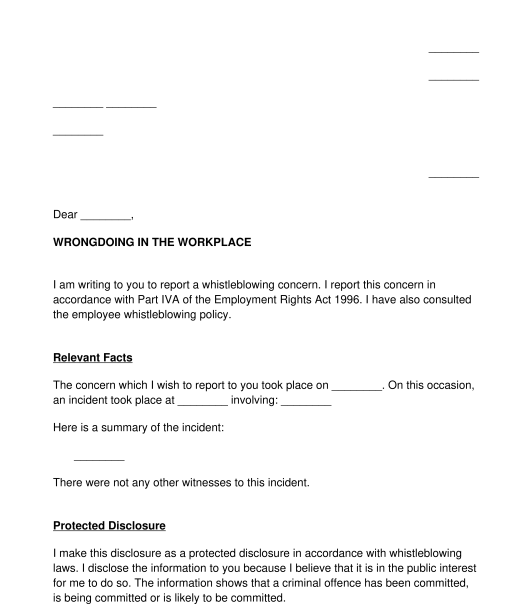 01/10/2025
01/10/2025

Answer a few questions and your document is created automatically.

Your document is ready! You will receive it in Word and PDF formats. You will be able to modify it.

 01/10/2025
01/10/2025
 Word and PDF
Word and PDF
 1 page
1 page
This document can be used by a worker in Great Britain in order to report a whistleblowing concern. The identity of the worker can be included in the letter. Alternatively, is possible to send this letter in an anonymised format.
Whistleblowing is the term used to describe the situation when a worker shares information about wrongdoing or malpractice in the workplace. Whistleblowing relates to a situation where the wrongdoing affects other people.
A member of staff will be protected under whistleblowing laws where they make a disclosure which they believe is in the public interest which could show past, present, or likely future wrongdoing amounting to any of the following:
A worker may report their concern to their employer, in accordance with the usual whistleblowing policy and procedures. If a worker does not feel able to report their concern to their employer directly, they can report this to an external body. The concern must however be reported to a prescribed body in order to be protected.
The law in Great Britain provides workers with legal protection in relation to whistleblowing, provided that this is done in the correct manner. The legal protection ensures that workers are not subjected to detriment or victimisation for whistleblowing. The whistleblowing protection applies to a wide range of different types of workers. It is possible to read more about this on the Protect website.
It is very important for a worker to be sure that they will be protected by whistleblowing laws before making a report of wrongdoing. It can be very useful to seek advice about this via Protect.
Personal grievances are not covered by whistleblowing laws. Personal grievances might include things such as bullying, harassment, and discrimination. An employer should hold a separate policy to deal with personal grievances and the worker should therefore refer to this if they have a personal grievance. A different letter can be used to raise a personal grievance.
This document should be completed with the relevant factual information.
If the sender has chosen to send the letter anonymously then it is not necessary for the sender to sign the letter. For anonymous reports of wrongdoing, posting is the usual method for sending the letter.
If the sender has chosen to include their identity then they can send the letter electronically via email. Alternatively, the letter can be printed, signed and posted.
Upon receipt of the letter, the concerns should be properly investigated by the recipient.
The Employment Rights Act 1996 (as amended by the Public Interest Disclosure Act 1998 and the Enterprise and Regulatory Reform Act 2016) is the relevant piece of law that protects workers in relation to whistleblowing.
The government has published whistleblowing guidance for employers and a code of practice. It may be helpful for workers to refer to this.
The charity Protect provides information and advice to workers about whistleblowing concerns.
You fill out a form. The document is created before your eyes as you respond to the questions.
At the end, you receive it in Word and PDF formats. You can modify it and reuse it.
Whistleblowing Letter - Sample, template - Word and PDF
Country: United Kingdom